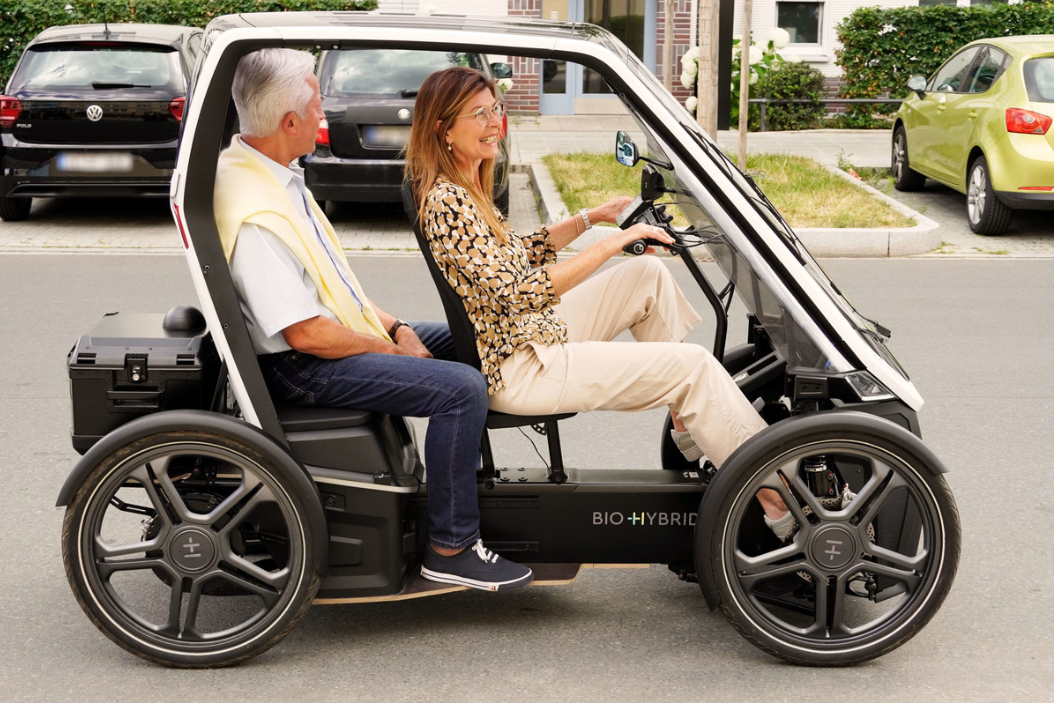
Car manufacturers making e-bikes, a completely new mobility plan for the city and lots of other innovations on mobility. This year the IAA car show (Internationale Automobil-Ausstellung) is really something else. (Read also IO news article).
This could be a new trend: Velomobiles. These vehicles represent the perfect combination of car and bicycle. With their weather-resistant bodywork and environmentally-friendly powertrain, they combine the best of both worlds. In the city traffic of the future, they could ensure more space and clean air.
Of course, there will also be a lot of e-cars on display at the IAA from the usual suspects: Mercedes, Audi, Porsche, VW and of course Bavaria’s very own BMW. Ford, Hyundai, Volvo will also be represented. But there will be other manufacturers on site that are not household names: the Cupra Formentor and Dacia Spring. The Chinese producer Great Wall Motors will be on hand with its car Wey, but Chinese producer Nio will not. Tesla will not be present, either.

But the XEV Yoyo car from Turin, Italy is not only electric. Its parts are all manufactured with 3D technology, allowing for fewer components, faster technical updates and significantly reduced production cycles. The savings from reduced production costs can be passed on to customers. Because it is customizable both inside and out, there is a large range of colors available. It has keyless entry with an app that also allows the driver to track the status of the lithium battery.
The XEV Yoyo is designed to be a city car with a maximum speed of 80 km. It has a range of 150 km, but it can carry a rechargeable battery in the trunk and easily swop it on the road. The price is listed on the website at just €9,700.
Visitors can reserve a vehicle to test drive using the IAAA app. It can be downloaded here. For a complete listing of test-drive vehicles, click here.

The Blue Lane
Apart from speeches and panel discussions, visitors will be able to experience the mobility of the future for themselves. For what would an event on “mobility” be with no movement?

That’s where the Blue Lane comes into play. Visitors will have the opportunity to test drive the latest in mobile technology themselves. The Blue Lane is a newly-created axis between the two venues of the trade fair. It joins the downtown Munich exhibition area and the Summit on the trade fair grounds just east of the city. It consists of three parts: road, public transport and micromobility. It is a designated priority lane to enable test drives. Visitors can drive demo vehicles, ride on shuttles or if they prefer, ride the U-Bahn metro line.
A five-kilometer section of the Blue Lane will serve as an official environmental lane, a route reserved exclusively for zero-emission vehicles and carpool vehicles with at least three occupants. From e-scooters to e-bikes, visitors can rent various means of transportation in Micro Mobility Hubs and test them on the nearly a kilometer-long public bike path on the Brienner Strasse in the middle of the city.
Bicycles get a boost from COVID-19
The World Cycling Forum (WCF) is being held simultaneously within the auspices of the IAA Mobility, from 6 – 7 September. It brings together bike manufacturers, retailers, brands and stakeholders. While many sectors have suffered from the pandemic, bicycles and e-bikes soared in popularity.
The Blue Lane also includes the Blue Lane Bike from the Riem exhibition center to Königsplatz in downtown Munich. There is also a one-hour bike trek, a signposted route from Munich-Riem through the districts of Trudering and Haidhausen, across the Isar River to historic Lehel and into the city center.

This is a trade fair first: An autonomous shuttle bus on the Summit grounds will ferry groups of visitors from A to B and in the Western parking garage. An automated valet parking system will also be presented by cooperation partners.
Participants can shape the future of mobility
The Mobilitython.com is a rapid prototyping competition with a focus on Open Innovation for experts in the mobility industry. This year’s focus is on data and IoT in rural areas and the smart city. The challenges are structured such that they can be solved on a part-time basis with manageable effort. This contest is backed by the German Federal Ministry of Transport and Digital Infrastructure, IAA Mobility and The Impact Farm, an SME company-builder focused on data science in the supplier industry. The Mobilitython.com challenge runs from 30 August to 11 September. To sign up, click here.
What’s gaming got to do with cars?
Quite a lot, it turns out. Just as many companies look to amazon for best practices in online shops, they would be wise to look to the gaming industry for a cutting-edge user experience. Gamers are accustomed to the best VR technology the industry has to offer. This gives them razor-sharp recognition of a substandard user experience provided by the dashboard of a car, for example.
Gaming industry expert Manouchehr Shamsrizi cuts to the chase: “Companies that take no account of gaming jeopardize their competitiveness.” People in gaming learn very early on how future technologies work and can apply this knowledge in their business models.

Also interesting:
Drive electric cars with an energy cream
It’s almost here: the first flying car from the Netherlands!
IAA shifts from being purely a car show to a future vision of mobility

